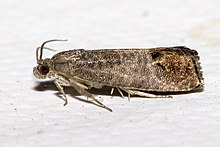| Cydia | |
|---|---|

| |

| |
| Imago (above) and caterpillar (below) of the codling moth (C. pomonella) | |
| Scientific classification | |
| Domain: | Eukaryota |
| Kingdom: | Animalia |
| Phylum: | Arthropoda |
| Class: | Insecta |
| Order: | Lepidoptera |
| Family: | Tortricidae |
| Subfamily: | Olethreutinae |
| Tribe: | Grapholitini |
| Genus: | Cydia Hübner, 1825 |
| Type species | |
| Phalaena (Tortrix) pomonella | |
| Diversity | |
| About 215 species (but see text) | |
| Synonyms | |
|
Numerous, see text | |
Cydia is a large genus of tortrix moths, belonging to the tribe Grapholitini of subfamily Olethreutinae. Its distinctness from and delimitation versus the tribe's type genus Grapholita requires further study.[1][2][3][4]
Moths in this genus are generally small and dull brown; their caterpillars are yellow or white and wormlike. Cydia includes many species of economic importance due to the damage their caterpillars inflict as pests of agricultural crops, especially fruit and nut trees. On the other hand, some Cydia species have been used for biological control of invasive weeds, and many of these small moths and their caterpillars are an important food source for other animals. A few species from the Hawaiian Islands are suspected to be extinct due to disappearance of their food plants.
Another well-known species is the jumping bean moth (C. saltitans), whose caterpillars live in Sebastiania seeds, turning them into the famous "Mexican jumping beans".
- ^ Baixeras, J.; Brown, J.W. & Gilligan, T.M. (2009a): Online World Catalogue of the Tortricidae – Genus Cydia account. Version 1.3.1. Retrieved 2009-Jan-20.
- ^ Baixeras, J.; Brown, J.W. & Gilligan, T.M. (2009b): Online World Catalogue of the Tortricidae – Cydia species list. Version 1.3.1. Retrieved 2009-Jan-20.
- ^ Savela, Markku (2005a): Markku Savela's Lepidoptera and some other life forms – Cydia. Version of 2005-Sep-13. Retrieved 2010-Apr-19.
- ^ Savela, Markku (2005b): Markku Savela's Lepidoptera and some other life forms – Grapholita. Version of 2005-Sep-13. Retrieved 2010-Apr-19.